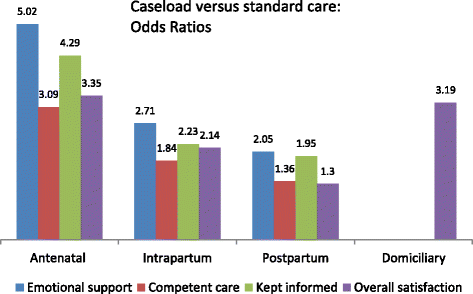Continuity of care by a primary midwife (caseload midwifery) increases women's satisfaction with antenatal, intrapartum and postpartum care: results from the COSMOS randomised controlled trial
- PMID: 26841782
- PMCID: PMC4739100
- DOI: 10.1186/s12884-016-0798-y
Continuity of care by a primary midwife (caseload midwifery) increases women's satisfaction with antenatal, intrapartum and postpartum care: results from the COSMOS randomised controlled trial
Abstract
Background: Continuity of care by a primary midwife during the antenatal, intrapartum and postpartum periods has been recommended in Australia and many hospitals have introduced a caseload midwifery model of care. The aim of this paper is to evaluate the effect of caseload midwifery on women's satisfaction with care across the maternity continuum.
Methods: Pregnant women at low risk of complications, booking for care at a tertiary hospital in Melbourne, Australia, were recruited to a randomised controlled trial between September 2007 and June 2010. Women were randomised to caseload midwifery or standard care. The caseload model included antenatal, intrapartum and postpartum care from a primary midwife with back-up provided by another known midwife when necessary. Women allocated to standard care received midwife-led care with varying levels of continuity, junior obstetric care, or community-based general practitioner care. Data for this paper were collected by background questionnaire prior to randomisation and a follow-up questionnaire sent at two months postpartum. The primary analysis was by intention to treat. A secondary analysis explored the effect of intrapartum continuity of carer on overall satisfaction rating.
Results: Two thousand, three hundred fourteen women were randomised: 1,156 to caseload care and 1,158 to standard care. The response rate to the two month survey was 88% in the caseload group and 74% in the standard care group. Compared with standard care, caseload care was associated with higher overall ratings of satisfaction with antenatal care (OR 3.35; 95% CI 2.79, 4.03), intrapartum care (OR 2.14; 95% CI 1.78, 2.57), hospital postpartum care (OR 1.56, 95% CI 1.32, 1.85) and home-based postpartum care (OR 3.19; 95% CI 2.64, 3.85).
Conclusion: For women at low risk of medical complications, caseload midwifery increases women's satisfaction with antenatal, intrapartum and postpartum care.
Trial registration: Australian New Zealand Clinical Trials Registry ACTRN012607000073404 (registration complete 23rd January 2007).
Figures


References
-
- Department of Human Services Victoria . Future directions for Victoria’s maternity services. Melbourne: Victorian Department of Human Services; 2004.
-
- McLachlan H, Forster D, Davey M, Farrell T, Gold L, Biro M, et al. Effects of continuity of care by a primary midwife (caseload midwifery) on caesarean section rates in women of low obstetric risk: the COSMOS randomised controlled trial. BJOG. 2012;119(12):1483–1492. doi: 10.1111/j.1471-0528.2012.03446.x. - DOI - PubMed
-
- Hatem M, Sandall J, Devane D, Soltani H, Gates S. Midwife-led versus other models of care for childbearing women. Cochrane Database Syst Rev. 2008;4:CD004667. - PubMed
-
- Rowley MJ, Hensley MJ, Brinsmead MW, Wlodarczyk JH. Continuity of Care by a midwife team versus routine care during pregnancy and birth: a randomised trial. Med J Aust. 1995;163:289–93. - PubMed
Publication types
MeSH terms
Associated data
LinkOut - more resources
Full Text Sources
Other Literature Sources
Medical

